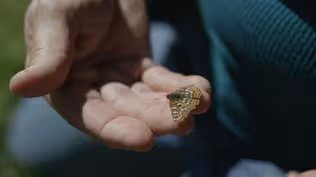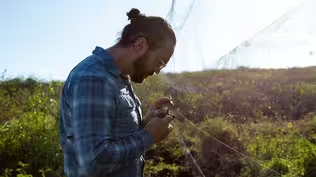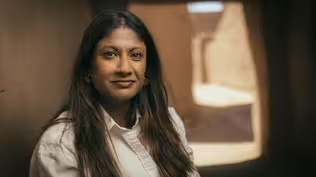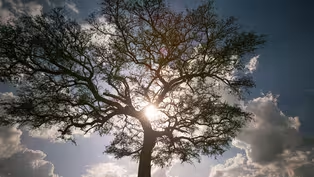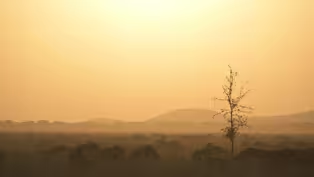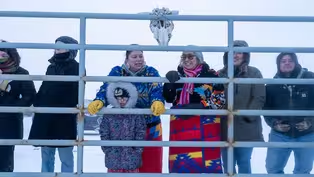
Scientists Look to Soil for Answers on Climate Change
Clip: Episode 5 | 3m 7sVideo has Closed Captions
Plants are reacting to our changing climate so scientists are looking to soil for answers.
Plant life on our planet is reacting to the changing climate. So scientists like Jane Zelikova are turning to the soil for an insight as to what is going on. Here in Kansas we see her and her research colleague Dr. Megan Machmuller digging down to take soil and root samples. She explains how grass systems play a vital role in carbon sequestration and the importance of necromass.
Problems playing video? | Closed Captioning Feedback
Problems playing video? | Closed Captioning Feedback

Scientists Look to Soil for Answers on Climate Change
Clip: Episode 5 | 3m 7sVideo has Closed Captions
Plant life on our planet is reacting to the changing climate. So scientists like Jane Zelikova are turning to the soil for an insight as to what is going on. Here in Kansas we see her and her research colleague Dr. Megan Machmuller digging down to take soil and root samples. She explains how grass systems play a vital role in carbon sequestration and the importance of necromass.
Problems playing video? | Closed Captioning Feedback
How to Watch Evolution Earth
Evolution Earth is available to stream on pbs.org and the free PBS App, available on iPhone, Apple TV, Android TV, Android smartphones, Amazon Fire TV, Amazon Fire Tablet, Roku, Samsung Smart TV, and Vizio.
Buy Now

Evolution Earth
Traveling to the far corners of the world, we discover the extraordinary ways animals are adapting to our rapidly changing planet. We witness nature’s remarkable resilience, as our perception of evolution and its potential is forever transformed. Read these interviews with experts to learn more.Providing Support for PBS.org
Learn Moreabout PBS online sponsorship[Shane] It's only now that we're clocking the extent to which our plant life is reacting to our changing planet... and running with this new understanding, some folks are looking to our grasslands with a new excitement.
[shovel scraping earth] Jane Zelikova is one of those people.
[Jane] There we go.
Nice.
Wow!
Look at that.
[Shane] Jane believes grasslands could be our greatest weapon of defense against climate change.
Once again, the secret is in the soil.
[Jane] Oh!
I love it.
I just want to keep touching it.
[Shane] Jane is a connoisseur.
Full of body, oaky, grassy tones.
Like the way people describe wine, like, I think we could talk about soil that way.
You should put it in a bottle.
People should have a chance to be able to, like, put this in their house and have it smell like this.
So we're lifting up!
[Shane] Not everyone is quite as excited by soil as Jane.
[Jane] Let's get this soil.
[woman] Ready?
She's been traveling across the country, digging holes and analyzing the soil composition in the few remaining undisturbed grasslands.
[Jane] Here she comes!
Here she comes!
Look at how dark it is.
Oh, there she is!
That's really good.
Look at that!
Beautiful!
These are kind of the magical soils that you dream of.
[Shane] She ain't wrong.
They really are something special.
[Jane] It's basically black all the way down.
So dark soil like this probably tells us there's a lot of organic matter in here.
[Shane] This is premium stuff!
[Jane] Ah, man!
The roots here are just prolifically insane.
Like, they're just abundant and deep and... hairy.
What we see above ground is just a small portion of all the biomass.
[Shane] The blades of grass we all see really are just the tip of the iceberg.
[Jane] Actually, the bulk of it is below ground in these roots.
[Shane] Jane's research shows that undisturbed, established grasslands have an immense ability to suck carbon dioxide out of our atmosphere, taking it through the giant network of roots, making the soil a huge reservoir for carbon.
[Jane] The way that you get more carbon in soil is because microbes do this major kind of soil transformation process by taking organic matter that's in the soil, and they transform it by eating it essentially and turning it into carbon, and the bulk of the really long-term kind of carbon that's stored in the soil is actually dead microbes.
We call that necromass.
Video has Closed Captions
Preview: Ep5 | 30s | Forgotten and overlooked, grasslands could hold the key to our planet’s survival. (30s)
A Growing Number of Wildebeest In the Serengeti
Video has Closed Captions
Clip: Ep5 | 3m 16s | Wildebeest numbers rose after eradicating rinderpest. The Serengeti ecosystem rebounded. (3m 16s)
A Herd of Buffalo Are Returned to the Fort Peck Reservation
Video has Closed Captions
Clip: Ep5 | 5m 45s | A momentous occasion as a new Buffalo herd are returned to the Fort Peck Reservation. (5m 45s)
Providing Support for PBS.org
Learn Moreabout PBS online sponsorship
- Science and Nature

Explore scientific discoveries on television's most acclaimed science documentary series.

- Science and Nature

Capturing the splendor of the natural world, from the African plains to the Antarctic ice.












Support for PBS provided by:
